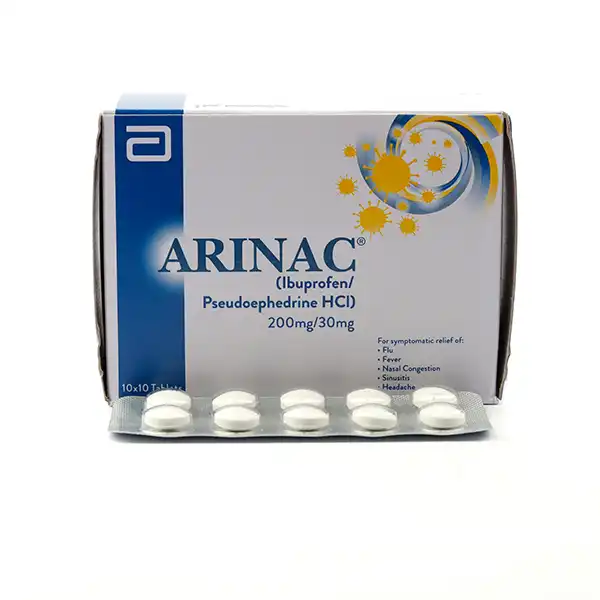Arinac Tab 200 Mg 10x10s-Potential Overview
Brand Name: Arinac
Generic Name: Ibuprofen and Pseudoephedrine
Active Ingredient(s): Ibuprofen (200 mg), Pseudoephedrine (30 mg)
For the General Public:
Uses:
Arinac is commonly used for the treatment of conditions such as pain, inflammation, and nasal congestion. It works by combining two active ingredients: Ibuprofen, which reduces pain and inflammation, and Pseudoephedrine, which helps relieve nasal congestion.
Dosage:
Take one tablet 3-4 times per day, preferably after food. Always follow the instructions on the packaging or as prescribed by your doctor.
Possible Side Effects:
Some common side effects may include dizziness, nausea, headache, and stomach upset. If you experience anything unusual, contact your healthcare provider immediately.
Common Side Effects:
- Dizziness
- Nausea
- Stomach upset
- Insomnia
Serious (Less Common) Side Effects:
- Gastrointestinal bleeding
- Heart palpitations
- Difficulty breathing
Important Information:
- Do not take this medicine if you are allergic to Ibuprofen, Pseudoephedrine, or any of the excipients.
- If you are pregnant, breastfeeding, or planning to become pregnant, consult your doctor before use.
- Keep out of reach of children.
- If you miss a dose, take it as soon as you remember unless it’s almost time for the next dose. Do not double the dose.
Dosage Instruction:
- Take as prescribed, generally 200mg of Ibuprofen and 30mg of Pseudoephedrine, 3-4 times daily.
- Take with food to minimize stomach irritation.
Usage Instruction:
- Take with food to reduce gastrointestinal irritation.
General Information:
- Do not take this medicine if you are allergic to Ibuprofen or Pseudoephedrine or have a history of cardiovascular diseases, gastrointestinal ulcers, or severe renal impairment.
- Consult your healthcare provider if you are pregnant, planning to become pregnant, or breastfeeding.
Drug Interactions:
Interactions with Other Medications:
- Warfarin, corticosteroids, SSRIs may increase the risk of gastrointestinal bleeding.
- May interact with ACE inhibitors and diuretics, affecting their antihypertensive effects.
Interactions with Food:
- Food may reduce stomach irritation from Ibuprofen.
Regulatory Approval & Manufacturer:
- Manufactured by Abbott Laboratories.
- Approved for use by relevant health authorities.
Antidotes (If Over Dosage or Misused by Patients):
- Overdose may cause symptoms such as nausea, vomiting, dizziness, and stomach bleeding. Treatment includes supportive care, activated charcoal, and symptomatic treatment.
For Pharmacists
Medicine Name: Arinac Tab 200mg/30mg
Brand: Arinac
Active Ingredient(s):
- Ibuprofen (200 mg)
- Pseudoephedrine (30 mg)
Indications:
Indicated for the management of pain, inflammation, and nasal congestion associated with conditions such as colds, flu, sinusitis, and minor aches and pains.
Pharmacodynamics:
- Mechanism of Action:
Ibuprofen, a nonsteroidal anti-inflammatory drug (NSAID), acts as an analgesic, anti-inflammatory, and antipyretic by inhibiting cyclooxygenase (COX) enzymes, which are responsible for producing prostaglandins that mediate inflammation and pain.
Pseudoephedrine, a sympathomimetic drug, works as a decongestant by stimulating alpha-adrenergic receptors, causing vasoconstriction in the nasal mucosa, thus reducing nasal congestion.
Pharmacological Effects:
- Ibuprofen: Reduces pain and inflammation, lowers fever.
- Pseudoephedrine: Relieves nasal congestion by narrowing blood vessels in the nasal passages.
Receptor Binding:
- Ibuprofen: Primarily binds to COX-1 and COX-2 enzymes, reducing prostaglandin production.
- Pseudoephedrine: Binds to adrenergic receptors to reduce swelling in the nasal passages.
Pharmacokinetics:
- Absorption:
Both active ingredients are rapidly absorbed after oral administration. Peak plasma concentrations of Ibuprofen typically occur within 1-2 hours.
Pseudoephedrine reaches peak plasma concentrations in approximately 2-3 hours.
- Distribution:
Ibuprofen is extensively bound to plasma proteins (approximately 99%) and has a volume of distribution (Vd) of about 0.1-0.2 L/kg.
Pseudoephedrine is widely distributed in the body, including to the central nervous system, with a moderate degree of plasma protein binding (55%).
- Metabolism:
Ibuprofen is metabolized in the liver via cytochrome P450 enzymes, primarily CYP2C9.
Pseudoephedrine is primarily metabolized in the liver and excreted unchanged in the urine.
- Elimination:
Ibuprofen is excreted via the kidneys.
Pseudoephedrine is also excreted mainly unchanged in the urine.
- Half-Life:
- Ibuprofen: Approximately 2 hours.
- Pseudoephedrine: Approximately 5-10 hours.
- Bioavailability:
Ibuprofen has a bioavailability of approximately 80%, while Pseudoephedrine has about 40%.
- Time to Peak Concentration:
- Ibuprofen: 1-2 hours
- Pseudoephedrine: 2-3 hours
- Effect of Food:
Food may delay the absorption of Ibuprofen but does not significantly affect Pseudoephedrine absorption.
Dosage and Administration:
- Adults:
- Ibuprofen 200 mg and Pseudoephedrine 30 mg, one tablet 3-4 times daily with food.
- Maximum daily dosage: 1200 mg of Ibuprofen and 240 mg of Pseudoephedrine.
- Pediatric:
Not typically recommended for children under 12 years of age unless directed by a healthcare provider.
- Special Populations:
- Elderly: No dose adjustment necessary for elderly patients, but caution is advised due to potential renal function decline.
- Hepatic Impairment: Use with caution, as reduced liver function may impair metabolism of both active ingredients.
- Renal Impairment: Use with caution in patients with impaired renal function, as both drugs are excreted via the kidneys.
Contraindications:
- Known hypersensitivity to Ibuprofen, Pseudoephedrine, or any excipients in the formulation.
- Contraindicated in patients with severe renal impairment, active gastrointestinal bleeding, or uncontrolled hypertension.
Warnings and Precautions:
- Use with caution in patients with a history of gastrointestinal issues (ulcers, bleeding).
- Monitor blood pressure in patients using this drug, as Pseudoephedrine may cause hypertension.
- May cause dizziness or drowsiness, so caution is needed when driving or operating heavy machinery.
Drug-Drug Interactions for Pharmacist:
Potential interactions with:
- Antihypertensives (ACE inhibitors, Beta-blockers, Diuretics):
Pseudoephedrine may reduce the effectiveness of antihypertensive medications due to its vasoconstrictive effects, which can increase blood pressure. Monitor blood pressure regularly when used in combination with these medications.
- Anticoagulants (Warfarin):
The risk of bleeding may increase when taking Ibuprofen with anticoagulants like Warfarin. Ibuprofen may inhibit platelet aggregation, increasing the risk of bleeding.
- SSRIs (Selective Serotonin Reuptake Inhibitors):
Concomitant use of Ibuprofen with SSRIs (e.g., Fluoxetine, Sertraline) increases the risk of gastrointestinal bleeding.
- Other NSAIDs:
Using multiple NSAIDs concurrently, including Ibuprofen, increases the risk of gastrointestinal ulcers and bleeding.
- Corticosteroids:
Co-administration with corticosteroids can increase the risk of gastrointestinal side effects such as ulcers and bleeding.
Drug-Food Interactions for Pharmacist:
- Food:
The presence of food may delay the absorption of Ibuprofen but does not significantly affect the absorption of Pseudoephedrine. Taking the medicine with food can help minimize gastrointestinal irritation, particularly from Ibuprofen.
- Alcohol:
Alcohol should be avoided when taking this medication, as it can exacerbate the risk of gastrointestinal bleeding or irritation caused by Ibuprofen, and it may increase the sedative effects of Pseudoephedrine.
Adverse Reactions:
Common:
- Dizziness
- Nausea
- Stomach upset (gastritis, indigestion)
- Insomnia
Serious:
- Gastrointestinal bleeding or ulcers: This is a risk with Ibuprofen, especially when used long-term or in higher doses.
- Hypertension: Pseudoephedrine may elevate blood pressure, potentially leading to cardiovascular issues.
- Anaphylaxis: Though rare, allergic reactions to either Ibuprofen or Pseudoephedrine can occur, presenting as hives, difficulty breathing, or swelling of the face and throat.
- Heart issues: Such as arrhythmias or tachycardia, particularly with prolonged use or misuse of Pseudoephedrine.
- Severe liver damage: This could occur with overdose or misuse.
Therapeutic Effects:
- Ibuprofen: Reduces pain, inflammation, and fever by inhibiting prostaglandin synthesis.
- Pseudoephedrine: Relieves nasal congestion by constricting the blood vessels in the nasal passages, improving airflow and reducing congestion.
Storage:
Store at room temperature (20-25°C / 68-77°F) in a dry, airtight container. Keep away from direct light and moisture to maintain the drug’s effectiveness.
Packaging:
Available in tablet form, in packs of 10 x 10 tablets.
Clinical Considerations:
Pregnancy Category:
- Category C: Animal studies have shown an adverse effect on the fetus, but there are no well-controlled studies in humans. Use only if the potential benefit justifies the potential risk to the fetus.
Lactation Category:
- It is not known whether Ibuprofen and Pseudoephedrine are excreted in human milk. Caution should be used when administering this drug to nursing mothers, as both drugs could pass into breast milk.
Pediatric Category:
- Not recommended for children under 12 years without a doctor’s guidance.
Geriatric Category:
- Elderly patients may have increased sensitivity to the effects of both Ibuprofen and Pseudoephedrine. They may also be at higher risk for adverse effects such as gastrointestinal bleeding and hypertension.
Adult Category:
- Standard adult dosing applies unless specific adjustments are needed for renal or hepatic impairment.
Child Category:
- Not recommended for children under 12 years without medical supervision.
Other Considerations:
- Renal Impairment: Use with caution as both Ibuprofen and Pseudoephedrine are excreted via the kidneys. Reduced renal function may increase the risk of adverse effects.
- Hepatic Impairment: Both active ingredients are metabolized by the liver, so caution is required in patients with liver dysfunction.
Conclusion:
Arinac is an effective treatment for conditions such as pain, inflammation, and nasal congestion. By combining Ibuprofen for pain relief and Pseudoephedrine for decongestion, it can alleviate symptoms associated with cold, flu, and sinusitis. However, it is important to follow the prescribed dosage carefully to avoid side effects, especially gastrointestinal issues, hypertension, or potential drug interactions. Always consult with a healthcare provider before starting this medication, particularly if you have existing health concerns such as hypertension, renal impairment, or a history of gastrointestinal disorders.
Pharmacists should educate patients about the risks of potential interactions with other medications, the importance of adhering to the prescribed dosage, and the need for proper storage and disposal.
Courier delivery
DHL Courier delivery

 Arinac is an effective treatment for conditions such as pain, inflammation, and nasal congestion. By combining Ibuprofen for pain relief and Pseudoephedrine for decongestion, it can alleviate symptoms associated with cold, flu, and sinusitis. However, it is important to follow the prescribed dosage carefully to avoid side effects, especially gastrointestinal issues, hypertension, or potential drug interactions.
Arinac is an effective treatment for conditions such as pain, inflammation, and nasal congestion. By combining Ibuprofen for pain relief and Pseudoephedrine for decongestion, it can alleviate symptoms associated with cold, flu, and sinusitis. However, it is important to follow the prescribed dosage carefully to avoid side effects, especially gastrointestinal issues, hypertension, or potential drug interactions.
Reviews
Clear filtersThere are no reviews yet.